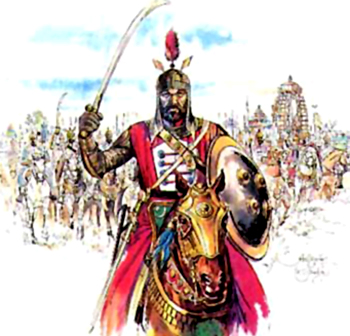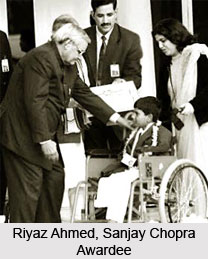 Disintegration of army in medieval India was a result of opposition. During the first thousand years of the medieval rule it has been observed that in spite of the foreign impact the army organisation in the country was not changed to a great extent. Lessons of Hydaspes were forgotten soon after and the armies continued to be flooded with large masses of untrained infantry, cumbersome chariots and the unwieldy elephants. Tribes who migrated to India had their bases in Punjab province and further west and until the time of the Kushans, Peshwar was their stronghold. It was from here that they kept an adequate watch on the frontiers and Indian arms were witnesses in the Central Asian regions crossing swords with the Chinese.
Disintegration of army in medieval India was a result of opposition. During the first thousand years of the medieval rule it has been observed that in spite of the foreign impact the army organisation in the country was not changed to a great extent. Lessons of Hydaspes were forgotten soon after and the armies continued to be flooded with large masses of untrained infantry, cumbersome chariots and the unwieldy elephants. Tribes who migrated to India had their bases in Punjab province and further west and until the time of the Kushans, Peshwar was their stronghold. It was from here that they kept an adequate watch on the frontiers and Indian arms were witnesses in the Central Asian regions crossing swords with the Chinese.
After the Kushana Empire there was a shift to the fertile Gangetic plains and the frontier areas, though at times under the influence of the central authority, mostly enjoyed independent status. The north western passes thus came to be neglected. There is the absence of a frontier policy all through the succeeding years. During the early Muslim inroads the rulers in the border areas held their own for a short while and at times formed confederations but in the absence of a unifying force, central command and well-organised armies they were defeated by the invaders. Indian history was then written on the Indo-Gangetic plains where empires were formed and lost time and again.
Armies in medieval era campaigned over vast areas; there was large scale fighting and the army organisation received great deal of attention. During the Huna incursions the Guptas took to the mobile cavalry and battled with the invaders who eventually settled in the Punjab and Central India. Though cavalry did not strike deep roots Harsha employed large numbers of this arm for his many campaigns. The Muslims entered India for the first time and Indian armies foiled their two early attempts with devastating results to the invaders. But when a large well equipped and trained army was again sent by them, with no corresponding efforts by Dahir his army was defeated. As pointed out this was due to bad leadership and lack of foresight.
Indian armies in the medieval period fought and always put up a bold front. There was no lack of heroism and feats of valour. They were, no doubt, ignorant of developments abroad and made no attempts to improve their organisations in the light of changed conditions. There was no unifying force and operations that went with them were a great drain on the country, in the destruction of the best youth of the day and then the devastation of vast areas of land which brought about shortages of food and famine. It has been stated that caste restrictions and the institution of the Rajputs, as being primarily responsible for the defence of the society, kept the other classes aloof from making an effective contribution to the national defence at the hour of crisis. The Rajputs provided the base for a standing army but there was no ban on others joining the armed forces. Indian history is full of regular campaigns and battles. It is, however, a fact that our laws of chivalry were generous to a fault and rules of warfare were strictly followed even in the gravest hour of crisis. But then the Muslims did not believe in dharma yuddha. Prithviraj allowed Muhammad Ghori to escape when he was wounded by him in the First Battle of Tarain and the latter in return ensured that Prithviraj was killed even though he was taken prisoner in the second battle. History is full of tales of valour and heroism.
Some of the reasons behind the disintegration of army in medieval India were insufficient training, being unbalanced and cumbersome. Small well-provisioned strongholds have always served as sentinels on the frontiers but when the country was divided and full of small states there could be no possibility of a common approach to this problem. Under these circumstances the invaders came in, crossed the passes and the main rivers of the Punjab. Even in the field of tactics old fashioned methods were employed. In the face of well trained cavalry charges their large forces were dispersed in no time. There seems to have been no notable attempt at meeting the invader. During the medieval rule, weight rather than quality seemed to be the main consideration.
On the other hand the Muslim armies were well knit, balanced and organised forces. Their light cavalry, united command, high morale and efficient leadership were their assets. The concept of jihad added fanaticism to their fighting in foreign lands. They travelled thousands of miles under their leaders in the hope of plunder and riches which they succeeded in getting each time. They, however, had the power of resilience and returned soon after with better equipment and well-trained armies. They had an efficient commissariat department to back up their campaigns. After establishing themselves in the country they ruled with a strong hand and perfected the organisation which became the army of occupation. All rebellions were ruthlessly crushed. Strong detachments were kept at the outposts; the north-western areas were guarded with a chain of well-garrisoned forts. The Mongols who gave no respite to the Delhi Sultanate were beaten and repulsed more than once. Though the Muslims established their rule in India they remained aliens with their predominantly foreign armies.
Slowly and gradually the deterioration of the army in Medieval India set in. Mobility was forsaken for static defences. The frontiers were left unguarded. Internal dissensions and palace intrigues sapped their strength. They never identified themselves with the local population. They became ease-loving and gave in to better equipped armies of the Mughals under Timur and then Babur who had been knocking at the gates of India. They too failed to keep abreast of the times. So when Babur came into India to found an empire he was faced with a Muslim army, which was destroyed with his highly trained cavalry, flank attacks and artillery.






